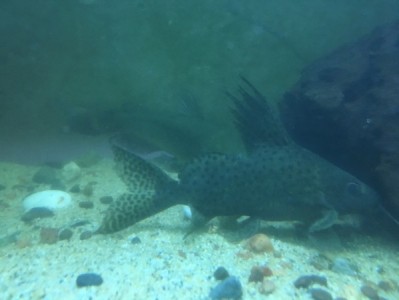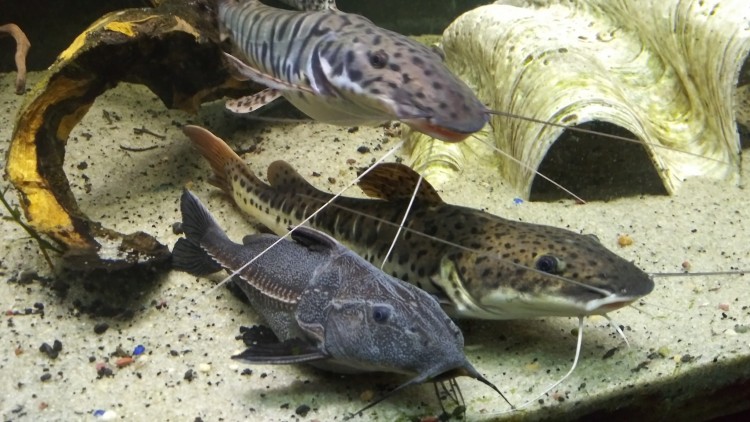- Name:
Synodontis Eupterus Catfish
(View AKA's) - Family: Mochokidae
- Species: Catfish
- Scientific Name: Synodontis eupterus


General info about Synodontis Eupterus Catfish
Synodontis eupterus is an upside-down species. The average adult in an aquarium is 6-8 inches and in the wild the average adult can reach 12 inches. Their body is dark brown with a few isolated small spots, adults have a dorsal fin in which each ray extends into long filaments that looks like a feather, giving it the common name of Featherfin Syno. To keep this species in an aquarium, the aquarium’s water should range between 72ºF and 81ºF, the substrate should be soft and there should be rocks, floating vegetation, caves and driftwood. This species becomes territorial as it matures, it becomes especially aggressive with other Synos and even more with its conspecifics, as such, it is not recommended to keep this species in a group unless the aquarium is large enough for each individual to have it’s own “home”. It can be kept in a community aquarium as long as its tankmates are large fish, any small fish in the aquarium may be seen as prey. Even with compatible tankmates it can be aggressive since it will try to establish itself as the boss of the tank, once it does, it will settle down. Even though it is a nocturnal species, after a while in an aquarium it will learn to emerge for food at any time of the day. It is a recommended species for beginners.
Synodontis Eupterus Catfish Diet & Nutrition
This species is omnivorous. In an aquarium it can be fed with prepared food for bottom dwellers, live food and frozen food. To keep an optimal health, it is advisable to feed a varied diet of prepared food, live/frozen food and vegetable matter ( for example, shelled peas).
Determining Sex of Synodontis Eupterus Catfish
Adult females are rounder than males.
Breeding & Spawning Synodontis Eupterus Catfish
There is no parental care and adults will prey on fry if given the chance.
Synodontis Eupterus Catfish Origin
This species can be found in 7 countries in Africa ( Guinea, Mali, Nigeria, Cameroon, Chad, Sudan and Ethiopia). It inhabits waters with a muddy bottom and can be found over rocks.
Caution with Synodontis Eupterus Catfish
They are bottom dwellers and so it is important to keep the substrate extremely clean to prevent them from getting infections on their barbs, for this reason, a sandy substrate is recommended. Even though they are bottom dwellers, they are not cleaners and will not survive on their tankmate’s leftovers. They have dorsal and pectoral spines that can become entangled in the mesh of a net so it is best to use a plastic container instead of a net to move them.
Original Detail
| Name | Species | Family | Scientific Name | More Detail | Added by |
|---|---|---|---|---|---|
| Synodontis Eupterus Catfish | Catfish | Mochokidae | Synodontis eupterus | Synodontis eupterus is an upside-down species. The average adult in an aquarium is 6-8 inches and in the wild the average adult can reach 12 inches. Their body is dark brown with a few isolated small spots, adults have a dorsal fin in which each ray extends into long filaments that looks like a feather, giving it the common name of Featherfin Syno. To keep this species in an aquarium, the aquarium’s water should range between 72ºF and 81ºF, the substrate should be soft and there should be rocks, floating vegetation, caves and driftwood. This species becomes territorial as it matures, it becomes especially aggressive with other Synos and even more with its conspecifics, as such, it is not recommended to keep this species in a group unless the aquarium is large enough for each individual to have it’s own “home”. It can be kept in a community aquarium as long as its tankmates are large fish, any small fish in the aquarium may be seen as prey. Even with compatible tankmates it can be aggressive since it will try to establish itself as the boss of the tank, once it does, it will settle down. Even though it is a nocturnal species, after a while in an aquarium it will learn to emerge for food at any time of the day. It is a recommended species for beginners. |
PalaciosAn |



